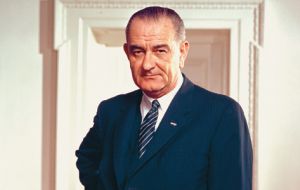Fifty years since the Gulf of Tonkin incident which triggered the Vietnam war
Tonkin #Tonkin

Saturday, August 9th 2014 – 07:12 UTC
 “Aggression by terror against peaceful villagers of South Vietnam has now been joined by open aggression on the high seas against the US”, President Johnson
“Aggression by terror against peaceful villagers of South Vietnam has now been joined by open aggression on the high seas against the US”, President Johnson
Fifty years ago, a controversial confrontation in the Gulf of Tonkin between the United States and North Vietnam forces set the stage for what eventually became US involvement in the Vietnam War.
US divisive escalation in Vietnam began several months before President Lyndon B. Johnson first deployed American troops on Vietnamese soil in 1965, with an oft-forgotten clash called the Gulf of Tonkin Incident.
During the presidencies of Harry S. Truman, Dwight D. Eisenhower and John F. Kennedy, the United States gave military and economic aid to South Vietnam, fight against North Vietnam’s Communist rebels, mostly in the form of military advisors.
This mostly passive relationship with Vietnam continued and evolved under President Lyndon B. Johnson’s administration. American warships were being sent on surveillance duty to gather electronic intelligence off the coast of North Vietnam in a covert operation codenamed DESOTO, which was initiated to help provide intelligence for the South — when they came face-to-face with North Vietnam forces.
According to a declassified NSA document archived by the National Archives and Records Administration, in August 2, 1964, an American naval ship, the destroyer USS Maddox, was cruising in the Gulf of Tonkin on a DESOTO mission when it was unexpectedly faced against three Soviet-built Northern Vietnamese torpedo boats.
“Apparently mistaking the Maddox for South Vietnamese, three DRV patrol boats launched a torpedo and machine gun attack on her,” the document timeline says. “Responding immediately to the attack, and with the help of air support from the nearby carrier Ticonderoga, the Maddox destroyed one of the attack boats and damaged the other two.”
The attack on the Maddox marked the first time the U.S. came under attack in Vietnam, and arguably set the country’s full-fledged involvement in action. The U.S. protested the attack to the International Criminal Court, warning Hanoi of “grave consequences” if U.S. ships were attacked again in the future. DESOTO surveillance was resumed by midday on August 3, augmenting the mission by adding another U.S. ship, the USS C. Turner Joy, to patrol the Gulf of Tonkin. However, late in the evening on August 4, the report says that a second attack on the DESOTO task force ships was launched by North Vietnamese boats, allegedly with as many as 22 torpedoes.
Most historians and military experts have since concluded that the second attack on American warships did not occur, many blaming misread sonar pings. “Review of action makes many recorded contacts and torpedoes appear doubtful,” the Maddox commanding officer reportedly communicated after evading the alleged torpedo attacks. “Freak weather effects and overeager sonar men many have accounted for many reports.”
Still, the attack that may never have happened had very real consequences.
Lyndon B. Johnson responded swiftly, ordering air strikes against North Vietnamese boat bases, and addressed the people of the United States that evening using the latest attacks as a pretext for what would eventually become on the ground involvement in Vietnam.
“Aggression by terror against the peaceful villagers of South Vietnam has now been joined by open aggression on the high seas against the United States of America,” Johnson said in the address. By August 7, Johnson unanimously passed the Gulf of Tonkin Resolution in the House of Representatives, a resolution which allowed him to enter war in Southeast Asia.
By March, 1965, the first U.S. combat troops had touched down on Vietnamese soil, with thousands more on their way. The war would not end until 1975 with Hanoi unifying the whole of Vietnam.